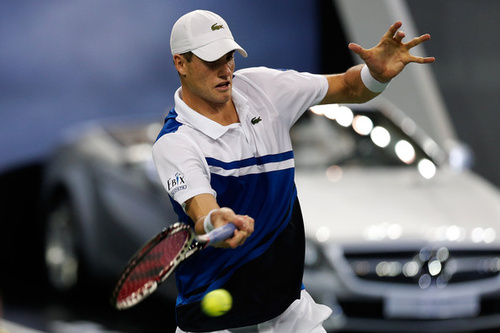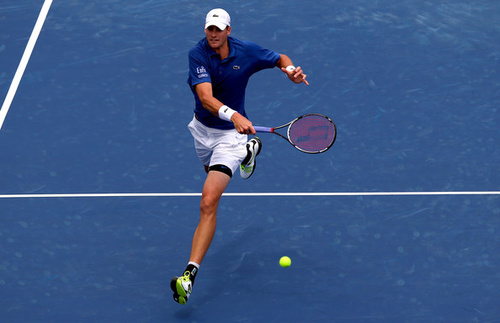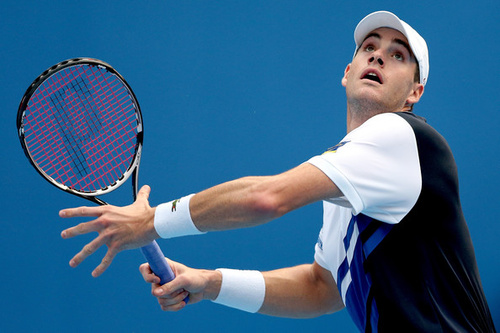Don't miss any stories → Follow Tennis View
FollowATP Predictions for 2014 (Part II): John Isner Surges
Australian contributor Matt Tewhatu returns with the latest edition of an offseason series on what to expect from the ATP in 2014.
His rise has been anything but meteoric, but John Isner is finally finding his way on the ATP World Tour. After experiencing a 2013 season interspersed with key wins over opponents in the top 10, he is becoming a real threat. We may be heading toward a time when the Big Four of Rafael Nadal, Novak Djokovic, Andy Murray, and Roger Federer will loosen their grip on the majors as the next generation of champions evolves. One feels that the time is drawing nearer for Isner, among others, to fulfill his potential and start consistently competing with the ATP top five in 2014.
Matt’s second prediction: ”If Isner can maintain his fitness, he will crack the top 10 and reach the semifinals or better at a major in 2014.”

Sitting at No. 14 in the world rankings, Isner compiled a patchy 2013. After the loss to Nadal at the final of the Cincinnati Masters 1000 event in the build-up to the US Open, he struggled with the same injury that hampered his Australian hard-court season in January. As a result, he left little impact toward the end of the season with early losses in New York and the Shanghai and Paris Masters 1000 events. Until his third-round exit at the US Open, however, his results reflected a player on the rise and capable of cementing a spot in the top 10 for a prolonged period.
Having reaped huge support after his epic victory over Nicholas Mahut at Wimbledon in 2010, Isner reached his peak ranking of No. 9 in 2012. In the time since then, he has showed the world that, if he is fully fit, he can consistently compete with opponents inside the top 10. There are a number of reasons why Isner is good enough to make the journey to at least the second Friday of a grand slam in 2014, and his hard-court results in 2012 and 2013 show why. His physical attributes also separate him from the rest of the top 20, giving him a steep advantage in the critical area of the serve (pardon the pun). Furthermore, his ability to adapt to different environments puts him in good stead for an assault on the world’s top five starting at the Australian Open.
Despite Isner’s injury woes, his results during the 2013 American hard-court season are encouraging for American fans lamenting the retirement of their last men’s major champion. (Andy Roddick won the US Open in 2003.) He bounced back from a disappointing grass campaign at Wimbledon and Newport by winning his next tournament in Atlanta, defeating the big-serving Kevin Anderson in a grueling final of three tiebreak sets. Isner followed up that strong result with a finals appearance in Washington, where he extended the higher-ranked Juan Martin Del Potro to a final set.
The tournament that perhaps underlined his potency, however, came in Cincinnati. He went on a run of defeating four top-10 opponents, starting in the second round when he halted Richard Gasquet in straight sets. Isner then reeled off victories over the 10th-ranked Milos Raonic in straight sets and world No. 1 Djokovic in a three-set quarterfinal thriller. He rounded off a splendid tournament by avenging his Washington loss to the seventh-ranked Del Potro before losing to Nadal in two tiebreaks.

While Cincinnati was not the first Masters 1000 tournament where Isner had shown his abilities, this summer stretch was the first time in which he showed the ability to compete consistently for a prolonged periods. Isner went on a “giant-killing” streak in 2012 at the Indian Wells Masters 1000 tournament, defeating Djokovic before losing to Federer in the final, but that was a bright light between several early exits at smaller tournaments.
The towering American has shown that he can compete physically with the elite, but he also possesses a physical attribute that sets him apart from the rest of the top 20. Standing at 6’10”, Isner is the tallest player in the top 50. His long reach and large frame minimize the yardage that he needs to cover across the court, and his towering height allows his serve more depth than most others on the circuit.
But, as they often say in sport, an athlete’s greatest strength can also be their greatest weakness. There are two problems that Isner will have to navigate throughout the rest of his career. The first problem is that by possessing such a huge physique, he can be prone to injuries. These injuries undermined the beginning and the end of 2013 for the American. The second problem is that faster, more agile players who are smart at using angles and the low ball can be difficult to play for men as tall as Isner. Nevertheless, while physical vulnerabilities have affected him in his time on the ATP circuit, he has proved that he can adapt to different environments and different surfaces.
This trait is a credit to Isner’s versaility and a reason why he may be even more of a threat to the top five than some of the players ranked higher than him. While one of his titles in 2013 came on a hard court, his other title came on red clay in Houston. Combining those triumphs with the double grass crowns at Newport in 2011 and 2012, a very adaptable player emerges. Many far more accomplished players, such as Andy Murray, have not yet won a singles title on clay, which is a credit to Isner and his team. In fact, clay could suit Isner more than one might expect. The surface allows for more biomechanical movement in ground strokes and reduces the stress on his knees.
One key problem facing Isner is his drop in success outside the United States. All of his singles titles and singles finals have come in his home nation except for one title (Auckland 2010) and one finals appearance (Belgrade 2010). While this seems mostly a mental barrier, it still needs to be navigated.

In a way, Isner is a little unlucky to be the top American in the ATP at the moment. The United States is a proud tennis nation, yet the American men have failed to follow in the footsteps of their former major-winning countrymen, or equal the exploits of women’s champions such as Serena Williams. This trend has placed more pressure on Isner’s broad shoulders. Provided that he can stay fit, Isner has his best chance of reaching the last weekend of a major in 2014.
The most likely scenario is that he will achieve that feat at the US Open in August next year. There, the favorable conditions of a fast court combined with the home support will breed an ideal environment for Isner to reach a new milestone in his career.










